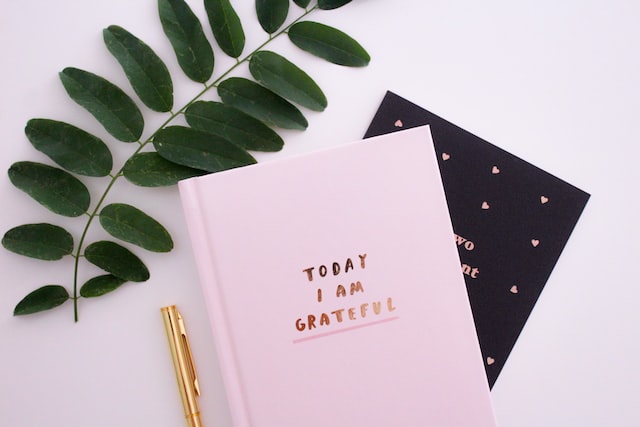When was the last time you intentionally practiced positive thinking? If you’re in a rut, it’s probably been a while since you wrote your own affirmations or took time to think about the things you’re grateful for.
Inviting positivity back into your life when you’re at a low point can be difficult. Sometimes you just have to fake it til you make it — that’s where a positivity journal comes in.
Positivity journaling can help you form a self-help habit that sticks. Five minutes a day is all it takes to jot down a few positive notes and reframe your mindset. Starting a daily writing practice can also be rewarding, as you’ll improve your skills as a writer and creative thinker.
Why Journaling Helps
If you’ve tried a few different self-help habits before, you might roll your eyes at the thought of journaling. But writing therapy does have the power to break us out of negative thought spirals and lead a more positive life.
Family therapist Elizabeth Sullivan echoes this sentiment and says, “most of us do not think in complete sentences but in self-interrupted, looping, impressionistic cacophony.” When writing, we can break this looping cacophony by “speaking to another consciousness — ‘the reader’ or another part of the self.”
So, as much as writing is about self-discovery, it’s also about breaking thought patterns and giving your brain more room to think. Writing down what’s on your mind can help you calmly work through the sources of your stress or anxiety and help you see life as it really is. This is particularly useful if you struggle with low body positivity or low self-esteem.
Starting a Journal
Starting a positive journal is easy. Ideally, you’ll purchase a notebook you like to write in and should get a few pens or pencils that have a nice tactile feel. You can also experiment with acrylic paints if you want to add a splash of color to your journal.
Next, choose a time of day that suits you best. Usually, folks journal when they wake up or before they go to bed. If you choose to journal in the morning, try to focus on your intentions for the day rather than what happened yesterday. Jot down any good feelings you have after waking up or happy dreams you may have had.
If you journal in the evening, go heavy on self-praise and don’t allow negativity to enter your journaling space. Even if you had a rough day, focus on the positives. You might, for example, journal about the exercise you did and the positive effect it is having on your health. Exercise can improve cognitive performance, slow aging, and lower stress hormones. Give yourself a pat on the back for any exercise you may have done (walking included!) as it will help form a stronger habit.
Journal Practices
You don’t always have to open your journal with a particular prompt or exercise in mind. Just writing about your day and the feelings you have is perfectly acceptable. You also shouldn’t feel pressured to make your journal into a presentable form of creative writing — no one else will read it, so cut yourself some slack.
However, if you do want to add writing exercises to your positivity journal, here are a couple of prompts and methods you might want to consider.
Felt Sense
Felt sense is a common form of therapy that helps you notice your feelings and where they emanate from. Compositionist Sondra Perl helps writers make use of this therapist by providing composition guidelines.
Perl’s composition guide for felt sense asks you to sit in a comfortable, safe space and explore your inner world. It’s perfectly acceptable to draw a blank when asking yourself questions like “how do I feel now?” as the answers you find aren’t as important as the practice of introspection.
Once you get to the end of Sondra Perls’ felt sense guided journal, look back over your entry and see if it “feels” complete. If it doesn’t, continue writing. If it does, try to notice the positive things you wrote about yourself or your particular topic. When you see these moments of positivity, invite yourself to smile. Smiling reduces stress, increases your productivity, and helps you form healthier relationships.
Guided Poetry
If you find the idea of writing prose about your life daunting or boring, you might enjoy guided poetry instead. This may be the case if your day job involves a lot of writing, but you still want to write for self-help reasons.
Guided poetry can also introduce you to new forms of poetic structure that you might like more than traditional forms. You can, of course, choose free verse as your structure and just let the words flow. But, if you want some structure, try the following forms:
- Haiku: three lines of five syllables, seven syllables, and five syllables, respectively. Great for short journal entries that don’t have to rhyme.
- Sestina: no rhyme scheme. Instead, you’ll repeat the same six words over 39 lines and six stanzas. Try to choose six words that encourage positivity.
- Couplets: two lines that rhyme with each other. You can simply write two lines and move on, or attempt to build on the couplet with other rhyming couplets.
Starting your day with low-stakes poetry is a great way to build some confidence in your creative ability. Likewise, ending your evening with a short haiku or a few couplets is a great way to slow your mind down and get ready for sleep. Don’t pressure yourself into creating a poem to be proud of — instead, find pride in the act of writing itself.
Conclusion
Keeping a positivity journal can be a great first step towards a happier, more productive life. Journaling helps with self-discovery and can interrupt negative thoughts before they take over. If it's your first time keeping a journal, try sticking to a regular time and choose an exercise that excites you. If you ever feel overwhelmed by the idea of journaling, try a short poetry exercise like jotting down some rhyming couplets or a quick haiku.

Author bio:
Frankie Wallace is a freelance writer from the Pacific Northwest. She writes about a variety of topics and spends her free time gardening.




Leave Comment